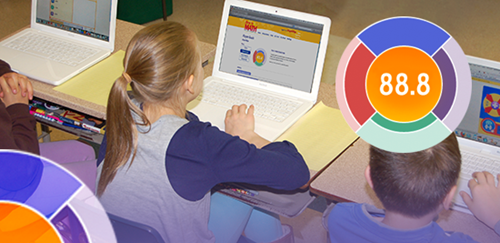EASTON, PA—If you’re a teacher and you’re not using the new First In Math Goals Index, you should be, says former teacher and current FIM Implementation Specialist Shawn Collier.

“Since introducing the Goals Index assessment tool in January 2015, the feedback I’m hearing from teachers has been awesome,” enthuses Collier. “Teachers are not just using it to evaluate their students, but the Goals Index is helping them talk with their students about math.”
Teachers can easily and quickly see what their students have—and haven't—done, and can turn that information into a conversation. “This is great on a number of levels,” according to First In Math Implementation Strategist Monica Patel. “It is imperative that we engage students in whatever it is they are learning about, and we shouldn’t be afraid to talk about where they struggle and where we're pushing the boundaries.” Teachers can use these conversations to move forward. “It is a great way to pass the baton to the students without it seeming like you are saying ‘okay kid you're slacking you have to pick it up,’ to them,” explains Collier.
“The Skills Index has been really helpful to both teachers and students,” says John Rice, Manager of Blended Learning at the Office of Teaching and Learning, District of Columbia Public Schools. Rice says that one of his teachers summed it up perfectly: “The Goals Index provides an easy-to-understand graphic that brings focus onto the skills that students are exploring, without emphasis on the stickers that they are earning.”
Teachers tell Rice the Goals Index encourages back-and-forth conversation with students. “They tell me it is easy to say ‘Hey! Why is everyone afraid to subtract 8?’ or, ‘I noticed a lot of people are trying integers, how is that going?’ without being judgmental.”
In the words of one DCPS teacher: “We have interesting conversations about what the students are exploring mathematically and I think it validates their exploration as a worthwhile experience. All in all, it is an improvement that can help us talk about math in a way that is more meaningful and accessible to the whole class.”
Examples like those provided by DCPS teachers do not surprise Collier. “The First In Math program is student-centered,” says Collier, who feels that the educational landscape may be slowly shifting. “I believe that we will see schools start moving away from all of the standardized tests and data points and looking for more opportunities to empower their students.”
“The First In Math Goals Index was launched after a year’s worth of discussion, planning, testing, feedback and tweaking. After seeing it in action I couldn't have asked for more,” says Suntex Vice President Barbara Asteak.*
“With input from countless sources in the education community and the creativity of our own talented team, we put a metric together that allows teachers to be even more effective with their students—both behaviorally and academically. That is definitely something to be proud of.”
* A version of the index has also just been released for students, allowing them to reference their individual progress.